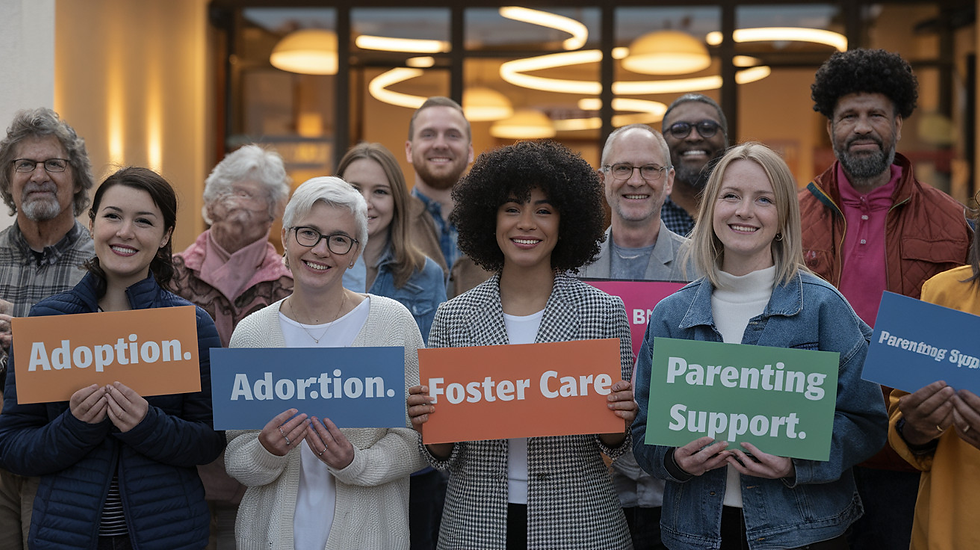NO SEX...NO BABIES...NO ABORTION
- Lady Janice

- Jan 2
- 5 min read
🚫 No sex, no babies, no abortion. It's a simple equation that's sparking heated debates across the globe. But is this oversimplified solution really the answer to one of society's most contentious issues?
In a world grappling with declining birth rates and ethical dilemmas surrounding reproductive rights, the "no sex" approach has gained traction. Yet, this seemingly straightforward concept raises profound questions about human nature, societal norms, and individual freedoms. Can abstinence truly be a viable solution to unwanted pregnancies and the abortion debate? Or are we merely sidestepping the root causes of these complex issues?
As we delve into this controversial topic, we'll explore the intricacies of the "no sex" approach, examine the factors behind declining birth rates, and investigate alternatives to abortion. We'll also tackle the ethical considerations that lie at the heart of this debate, challenging our preconceptions and pushing us to think critically about the future of human reproduction and family planning. 🤔💭

Understanding the No Sex Approach In NO SEX...NO BABIES...NO ABORTION
A. Benefits of abstinence
Abstinence offers several advantages as a pregnancy prevention method:
100% effectiveness in preventing pregnancy
No risk of sexually transmitted infections (STIs)
Zero cost for contraceptives
Eliminates potential side effects of hormonal birth control
B. Psychological impacts
The psychological effects of abstinence can vary:
Positive impacts | Potential challenges |
Increased self-control | Sexual frustration |
Reduced relationship pressure | Feelings of isolation |
Focus on personal growth | Potential impact on intimacy |
C. Social implications
Abstinence can influence social dynamics:
Shifts focus from sexual relationships to platonic friendships
May alter dating norms and expectations
Can impact social activities and environments
D. Health considerations
Practicing abstinence has various health implications:
Eliminates risks associated with sexual activity
May reduce stress related to pregnancy concerns
Could impact overall physical and emotional well-being
Abstinence, while effective for pregnancy prevention, requires careful consideration of its multifaceted impacts on individuals and society. As we explore this approach, it's important to understand how it relates to broader trends in birth rates and family planning.

The Decline in Birth Rates
Now that we've explored the no sex approach, let's examine the global decline in birth rates and its various contributing factors.
A. Global trends
Birth rates have been declining worldwide, with notable variations across regions. Here's a snapshot of global birth rate trends:
Region | Birth Rate (per 1,000 population) | Trend |
Europe | 10.2 | Declining |
North America | 11.8 | Stable |
Asia | 16.4 | Declining |
Africa | 32.6 | Slowly declining |
B. Economic factors
Economic considerations play a significant role in declining birth rates:
Rising cost of living
Increased focus on career advancement
Financial instability
Higher education expenses
C. Societal shifts
Changing societal norms have contributed to lower birth rates:
Delayed marriages
Increased acceptance of childless lifestyles
Greater emphasis on personal fulfillment
Improved access to contraception
D. Environmental concerns
Environmental factors are increasingly influencing family planning decisions:
Climate change awareness
Resource scarcity concerns
Overpopulation worries
E. Impact on population growth
The decline in birth rates has far-reaching consequences for population growth and demographics. As we move forward, it's crucial to consider how these trends will shape our societies and economies in the coming decades.
Next, we'll explore strategies for addressing unwanted pregnancies in light of these demographic shifts.

Addressing Unwanted Pregnancies
Comprehensive Sex Education
Comprehensive sex education plays a crucial role in preventing unwanted pregnancies. By providing accurate, age-appropriate information about sexual health, relationships, and contraception, we empower individuals to make informed decisions. Studies show that comprehensive sex education reduces risky sexual behavior and increases contraceptive use.
Access to Contraception
Ensuring widespread access to various contraceptive methods is essential for preventing unwanted pregnancies. This includes:
Hormonal methods (pills, patches, injections)
Barrier methods (condoms, diaphragms)
Long-acting reversible contraceptives (IUDs, implants)
Emergency contraception
Method | Effectiveness | Duration |
Pills | 91-99% | Daily |
IUDs | >99% | 3-10 years |
Condoms | 82-98% | Single use |
Family Planning Services
Family planning services offer:
Contraceptive counseling
Pregnancy testing and counseling
Basic infertility services
Preconception health services
Sexually transmitted infection prevention and treatment
These services help individuals and couples plan their families effectively, reducing the likelihood of unwanted pregnancies.
Support Systems for Expectant Parents
Developing robust support systems for expectant parents can help reduce the perceived need for abortion. This includes:
Financial assistance programs
Prenatal care services
Childcare support
Adoption services
Mental health resources
By addressing the root causes of unwanted pregnancies and providing comprehensive support, we can create an environment where abortion becomes less necessary. This approach aligns with both pregnancy prevention and ethical considerations surrounding reproductive choices.

Alternatives to Abortion
Now that we've explored the complexities of unwanted pregnancies, it's crucial to consider the range of alternatives available to those facing this difficult situation. These options not only provide support but also offer hope and possibilities for both parents and children.
Adoption Services
Adoption is a compassionate choice that can provide a loving home for a child while offering relief to those unprepared for parenthood. Modern adoption practices have evolved to prioritize the well-being of all parties involved.
Type of Adoption | Description | Benefits |
Open Adoption | Birth parents maintain some contact | Allows for ongoing relationships |
Closed Adoption | No contact between birth and adoptive families | Provides complete privacy |
Semi-Open Adoption | Limited contact through an intermediary | Balances privacy and connection |
Social Support Programs
Communities and governments offer various programs to assist new parents:
Temporary housing assistance
Job training and placement services
Childcare subsidies
Parenting classes and support groups
Financial Assistance for New Parents
Financial strain is a common concern for expectant parents. Several options exist to alleviate this burden:
Government assistance programs (e.g., WIC, TANF)
Non-profit organizations providing baby essentials
Tax credits and deductions for parents
Employer-sponsored parental leave and benefits
Counseling and Mental Health Resources
Emotional support is crucial during pregnancy and early parenthood. Mental health services can help individuals navigate this challenging time:
Individual and couples therapy
Crisis hotlines for immediate support
Support groups for new parents
Postpartum depression screening and treatment
These alternatives offer comprehensive support, addressing the various challenges that may lead someone to consider abortion. By exploring these options, individuals can make informed decisions that align with their values and circumstances.

Ethical Considerations
Personal Autonomy
Personal autonomy lies at the heart of reproductive ethics. Individuals have the right to make decisions about their bodies and future, including whether to engage in sexual activity or have children. This autonomy extends to choices about contraception and family planning methods.
Religious Perspectives
Religious views on sex, contraception, and abortion vary widely:
Religion | View on Contraception | View on Abortion |
Catholicism | Generally opposes | Opposes |
Islam | Permitted | Restricted |
Judaism | Generally accepts | Varies |
Buddhism | Accepts | Varies |
These diverse perspectives influence public policy and individual choices, highlighting the complexity of reproductive ethics.
Societal Responsibilities
Society bears responsibility for:
Providing comprehensive sex education
Ensuring access to contraception
Supporting family planning services
Addressing socioeconomic factors that influence reproductive decisions
Legal Implications
The legal landscape surrounding reproductive rights is complex and varies globally. Key considerations include:
Laws regulating abortion access
Contraception availability and coverage
Protection of personal autonomy in reproductive decisions
Balancing individual rights with societal interests
As we navigate these ethical considerations, it's crucial to recognize the interconnectedness of personal choices, societal norms, and legal frameworks in shaping reproductive health policies and practices.

The "No Sex, No Babies, No Abortion" approach presents a thought-provoking perspective on addressing complex reproductive issues. By exploring abstinence, declining birth rates, and alternatives to abortion, we've examined various facets of this controversial topic. The ethical considerations surrounding these issues remind us of the importance of informed decision-making and respectful dialogue.
Ultimately, reproductive choices are deeply personal and influenced by individual circumstances, beliefs, and societal factors. As we navigate these challenges, it's crucial to prioritize comprehensive sex education, accessible healthcare, and support systems for individuals and families. By fostering open conversations and promoting understanding, we can work towards creating a society that respects diverse viewpoints while ensuring the well-being of all its members.
.png)

Comments